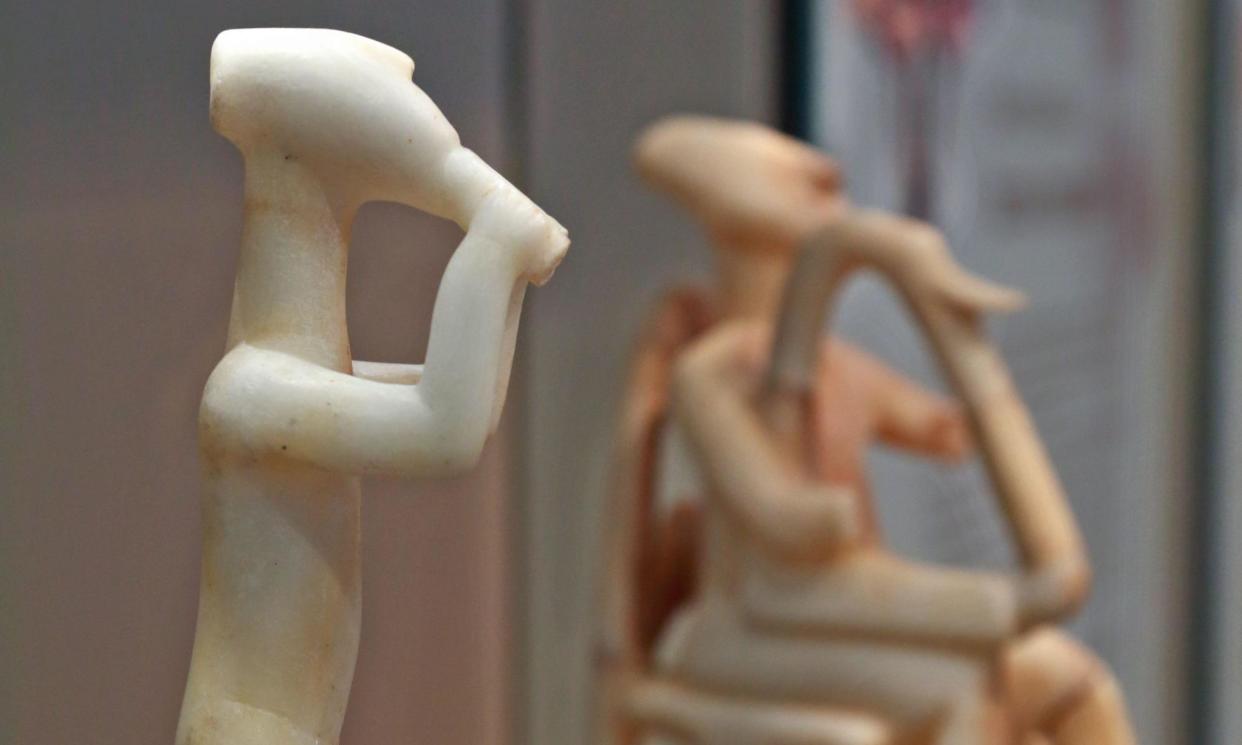Femicide surge: the Cycladic figures found in the Aegean show a deep respect for the female body. How did Greece lose this?

Tall, thin, small, wide, or shaped like a violin. Lying down, standing up, arms folded or looking up to the stars. Male, female, intersex or abstracted. Alone or in groups, drinking, or playing music. All these descriptions came to mind last week when I came into contact with some of the earliest known Greek figurine sculptures, known as Cycladic art.
Marble white – although originally painted – the Cycladic figures date from the Neolithic to early Bronze Age, around 5300–2300BC. They were sculpted in cultures based in the circular cluster of islands in the Aegean Sea known as the Cyclades. What began as pebble-shaped figurines grew into a great variety of shapes and sizes, sometimes with coiled hair and eyes drawn atop little wedge noses, and occasionally playing instruments.
Kyriaki Griva was killed while pleading for help outside a police station
They were discovered in the 19th century, found whole or broken in graves and tombs. Not much more is known about these mysterious, ethereal figures, made before written language became widespread. But looking at them is transfixing. They make you imagine what life was like in the ancient world; how different their civilisations were to ours.
One favourite figure in the Museum of Cycladic Art in Athens is called the Stargazer: an upside-down pear-shaped body, its head (with tiny ears intact!) tilting up to look upon the theatre of the stars, perhaps marvelling at its own tiny significance on earth, or simply relishing the cosmic world. I also loved the flute-player in the city’s National Archeological Museum, reminding me of the timeless joy of performance.
If you sit with these figures and feel the celebration of life within them, you will find yourself thinking about time, the longevity of objects, the traces left of ancient cultures, and the beauty and power of human bodies. Most of the Cycladic figures are female, during or after pregnancy, as evidenced by their swollen tummies forming a slightly protruding arc, or flat stomachs embossed with lines symbolising stretch marks. Fertility, as both giver of life and replenisher of land, was important to venerate in such cultures – and from the assortment of surviving nude female figurines it seems women’s bodies were especially revered for their seemingly miraculous powers. Many archeologists think midwives were regarded as the most powerful of all.
But seeing these figurines, serene and wondrous with their elegant folded arms tightly protecting their little stomachs, got me thinking about how pregnant bodies in art and visual culture have so often been concealed. They also made me think about the need to protect bodies at all costs, to celebrate their infinite capabilities. Bodies are for honouring and conserving, not objectifying, exploiting or destroying.
This particularly hit home when I was in Athens, as the headlines were dominated by the recent upsurge in femicides. Protesters have been taking to the streets to campaign for femicide to be recognised as a distinct crime in Greece. This came after the killing of a 28-year-old woman, Kyriaki Griva, apparently by her former partner, when pleading for help from the police outside a station in western Attica. There have also been numerous reports of violence against women, including one case in January in which a 41-year-old pregnant woman was allegedly murdered by her partner and his friend.
In response, Greece’s police minister has announced plans to establish a countrywide network of domestic abuse shelters. Although that will be a step in the right direction, further action is urgently required. And to trigger this move, it has taken the annual number of reported cases of domestic abuse to reach 10,000 – a figure that should be viewed alongside estimates suggesting that fewer than a quarter of cases are thought to get reported to the police. While it is good if women feel they can go to places for shelter, what about the children they might be looking after? And what will happen after they go home?
It shouldn’t be the victims who have to flee, who have to endure such upheaval. They should feel safe everywhere, at all times. What the issue highlights is an urgent need to educate people about the importance of honouring and respecting bodies. Although these Cycladic figurines stem from a culture that seems the opposite of ours, I think we can learn from them.
With their tranquil features and beautiful curves, which have survived wars, earthquakes, revolutions and more, they teach us about the preciousness of bodies, the need for them to be protected, not destroyed – and revered for their incredible abilities as givers of life.


